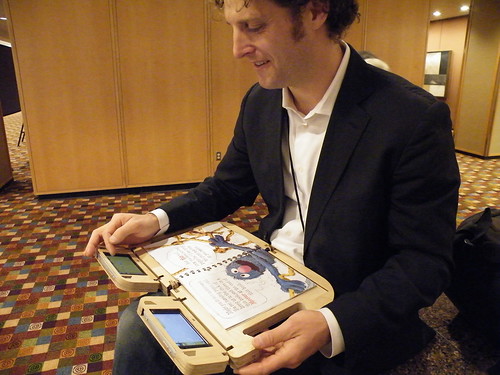Last month, industry and academic experts in human-computer interaction gathered in Atlanta for their annual CHI conference. The event was a chance for practitioners and theorists alike to share their work across a wide domain. A few of these projects focused on the domestic design space and bringing families together.
Family Story Play
Hayes Raffle presented a paper describing the early prototyping and testing of Family Story Play, a teleconferencing device to connect grandparents and grandchildren. Raffle, a Senior Research Research Scientist for design and user experience at the Nokia Research Center in Palo Alto, argued that young children don’t find talking on the phone to be intuitive. Rather than teaching kids how to stay engaged with disembodied voices, this design uses a shared activity with which most people are familiar—reading a book—to facilitate long-distance communication.
The prototype comprises of a folding wooden frame housing two Linux tablets, connected via USB to magnetic sensors and a book. One of the tablets serves as the video conferencing touch screen, showing Grandma and which page of the book she is currently reading. On the other screen is Elmo from Sesame Street, who acts as a catalyst for interaction as the generations read together. Thanks to the sensors and some creative input from Sesame Workshop, Elmo is aware of where they are in the storybook and can respond to content with pre-programmed prompts and reactions.
Raffle said some of the inspiration for the project came from personal experience trying to share the early life of his older daughter in Cambridge with family in California. Family Story Play is a collaboration between Nokia, the Sesame Workshop, and MIT’s Tangible Media Group.
Family Window
Working with Kodak, Tejinder Judge of Virginia Tech tested another form of video conferencing meant to strengthen intimacy over distance. The Family Window connects families with always-on video that can be annotated with on-screen ink. To address privacy concerns, there is no audio in the system, and each side of the connection can control how much video is shown using the electronic equivalent of blinds. The participating families adapted to the constraints by using the on-screen ink to leave status messages or playful annotations on images.
In the work presented at CHI, six families served as guinea pigs under varied conditions. Most had a dedicated tablet PC, but one used a multi-purpose laptop. This caused some miscommunication when a father-in-law appeared to be staring intently at the distant family when he was really browsing the web with his video window minimized.
The testing supported the notion that the mundane is a valuable means to strengthen existing relationships. Checking in visually often prompted impromptu conversation and let distant family members become aware of patterns that might never be brought up otherwise. Families could share in ordinary routines, like getting ready for bed or reading books, despite not being in the same room.
FM Radio
A third family-oriented design project was presented by Daniela Petrelli of the University of Sheffield, with support from Microsoft Research and Rice University. FM Radio (as in “Family Member”) had two parts to the research.
The first part asked ten families to collect sonic mementos of three days of vacation. Left to each family to determine what was important, these digital sound clips contained conversations, commentary, ambient sound, and varied forms of music. On the recording days, the families were asked to only use the recorder—no pictures—to force them to consider deeply how to preserve their memories through audio.
The second part revisited six of those family recordings a year later. During 90-minute sessions, each family was presented with a device that looked like an old radio. Without any instruction or explanation, they spent the time exploring the knobs and buttons and rediscovering the sounds they had previously captured.
What made FM Radio so compelling was the physical form and somewhat antiquated metaphor given these “sound souvenirs.” It was clearly an engaging activity that required some discussion to recall the context of each clip and to share new uses of the sounds created by playing with the radio controls.

